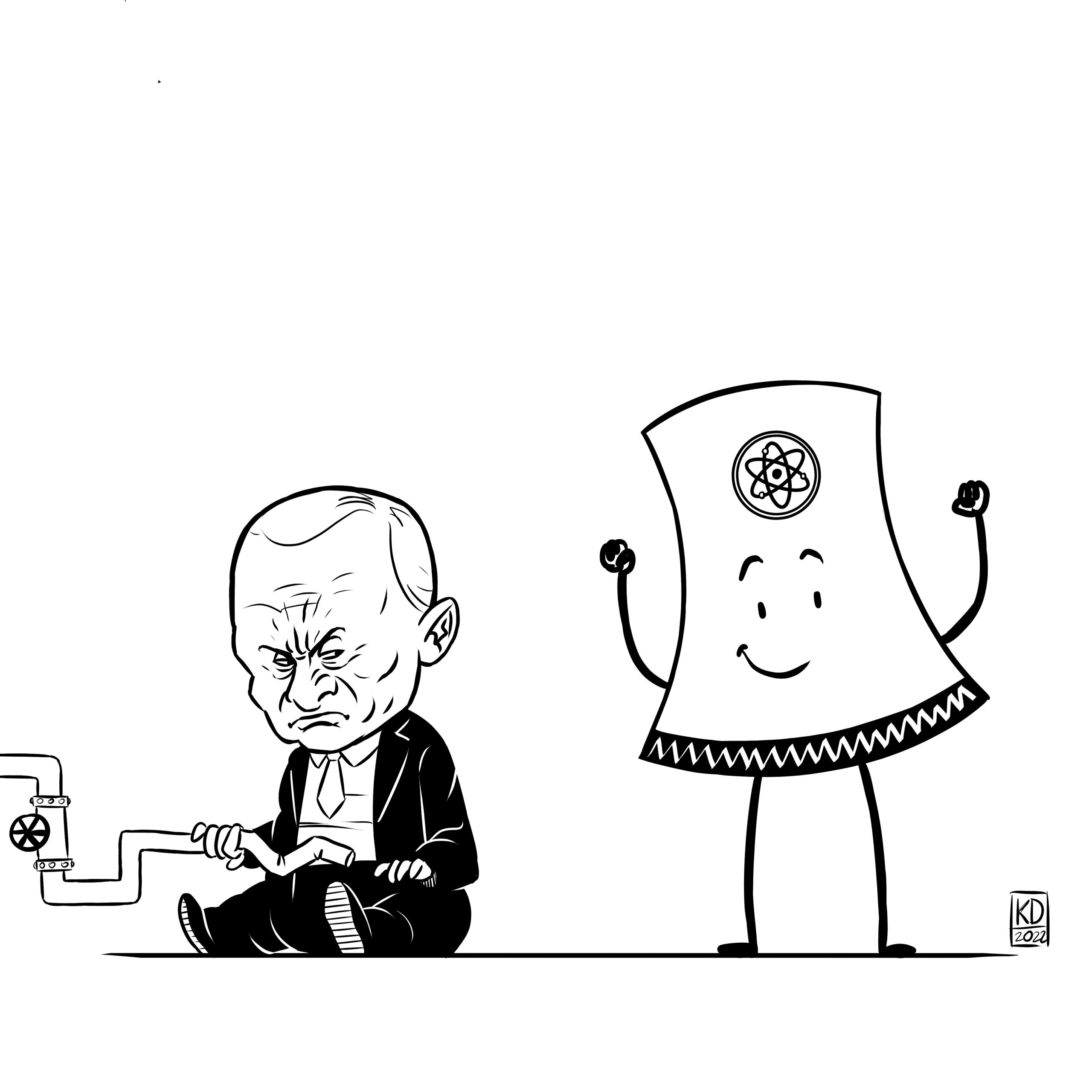Russian aggression has challenged the foundations of the long-standing energy policies of European countries, presumably forcing their deep reconstruction. The vision of a rapid elimination of coal by means of cheap Russian gas, supplied to Western Europe at a low price by the ‘somewhat eccentric’ but ‘fundamentally reliable’ Putin, has crumbled like a house of cards. The European Union is now facing key challenges: how to carve out a new path to climate neutrality in 2050? Is it possible to secure a large enough and cheap enough gas supply from other directions? And how much will all this cost the society and the economy?
EXECUTIVE SUMMARY
- severe economic sanctions imposed on Russia mean that the NordStream2 project will be put on hold or even completely terminated. Despite the fact that the EU has not yet (as of the date of publication of this text) blocked imports of raw materials from Russia, the loss of this country’s credibility will result in a permanent reduction in gas (and oil) orders from that source.
- There are several alternative scenarios in the EU. They are based on the assumptions of an accelerated transition towards meeting all energy demand through renewable sources, diversification (and de-Russification) of gas supplies, as well as a turn towards nuclear energy.
- The options of accelerating the transition and a rapid turn towards one hundred per cent RES are socially attractive and justified in terms of the concern for the future of the planet. However, they raise serious technological and financial issues: it is difficult to estimate the scale of the costs of such an emergency, high-speed conversion to greener Europe today.
- Considering the economic, geopolitical and social assessment of the energy choices that Europe has to face, there is a clear advantage in favor of the pro-nuclear option. Fully available, tested, safe and efficient technologies can provide completely climate-neutral energy at an acceptable price and therefore appear to be the optimal solution. Unfortunately, unanimity on this issue does not exist in Europe.
Energy-(in)secure Europe
When one observes some of the strategic political decisions taken in recent years and decades by wealthy European countries, one might get the impression that the infatuation with Francis Fukuyama’s vision of the end of the story presented in the early 1990s lasted until February 24, 2022. Indeed, Europe was planning its energy future on the basis of ambitious and noble goals of environmental protection, shifting the issues of economic competitiveness as well as security and independence of energy supply to the background. This tacitly assumed a constant correctness of relations with its Russian neighbor and the possibility of pursuing ‘business as usual’ in any political environment. The reaction of some Western politicians to the Ukraine tragedy gives the impression that they are trying to deny reality, hoping that the bad dream will soon be over and it will be possible to return to beautiful plans for a prosperous, carefree future.
The global drive to decarbonize as quickly as possible, as well as Germany’s denuclearization policy dating back to the 1970s, has led to a sharp increase in the importance of unstable renewables. Yet, despite gigantic investments and the EU’s consistent need to play its role as the world’s transformation pioneer, today merely (or perhaps as much as) 15 per cent of primary energy generated in the European Union comes from renewable sources. A significant side-effect of the processes of rapidly moving away from our own raw materials – mainly coal and lignite – has been increased dependence on fossil fuels, only exported. Or actually on one exported fuel, namely Russian gas.
Putin’s gas trap
To put it simply, the EU’s ambitious plan to reach climate neutrality as early as 2050 involves the rapid development of renewable capacity backed by stable sources, predominantly gas. While gas is also a fossil fuel, and its use also emits greenhouse gas such as carbon dioxide ( although in smaller quantities than coal equivalents), it has been considered that its use would be allowed for some time. The Russian-German Nord-Stream 1, Nord-Stream 2 ( the Baltic Sea) and the Russian-Turkish South Stream/TurkStream (the Black Sea) projects, were intended to provide a sustainable and secure supply of large volumes of raw material for the whole Europe. At the same time making the Russian exporter and its partners independent of Central European countries, including Ukraine and Poland.
The real effect of this structured decarbonization (and partial denuclearization) of Europe was an increased dependence on imports and a Russification of the directions of energy supplies. The continent’s energy security was based on the goodwill of the Kremlin regime, or the belief that its own profit was prioritized over the state’s strategic goals. Meanwhile, in preparing the war in Ukraine, the Kremlin already proved that gas supplies are first and foremost their weapon, hitting the wallets of the Europeans. Gazprom’s market manipulation at the turn of the year elevated gas prices in Europe, causing end customers to pay increases amounting to hundreds of percent, in a situation where gas prices in the US remained unchanged. But it wasn’t until the brutal aggression on the neighbor that Europeans seriously started to look for alternatives.
The question about the origin of the assumption that the Russian regime does not treat gas infrastructure projects instrumentally, as a political tool, remains open. It is hard not to see the cause-and-effect links with Gazprom’s gigantic investments in the prosperity of former politicians or in the ‘toys’ of Europeans such as football. Trying to show reality in a slightly different perspective to the common trend was not easy. Until recently, the argumentation related to energy security and the skeptical views on the pace and direction of the transition were considered a ”disguised pro-carbon option” in many circles. Unfortunately, there was good reason for this, as the energy security slogan was taken up by the noisy representatives of the mine-related union-business arrangements and the politicians dependent on them. As a result, the core of the public debate at the level of public and media discourse, was reduced to a choice between pro-climate solutions and environmental destruction. There was no room for rational, calm and sound argumentation, rather merely ad hoc political horseplay, with no medium or long term consideration. This enhanced the Putin trap effect further.
The dream of a fully renewable future
The shock therapy was sobering for the Western world. The search for alternative sources of energy to replace the shortfall in supplies from the East has begun in Europe. The possibilities are numerous: in addition to deposits on the continent and Norway’s resources, gas can be supplied by sea. The United States is the world’s largest producer of this raw material, along with Iran and Qatar. Poland is in a relatively good position – it has already made important decisions on the construction of a gas port in Świnoujście and a gas pipeline connection to the North Sea ( the Baltic Pipe). As a result, we can now think confidently about turning off the Polish-Russian Yamal gas pipeline at the end of 2022.
Replacing Russian gas with Qatari or Iranian gas is only a half-measure because, as it has already been pointed out, the use of gas involves the emission of CO2. Therefore, Europe’s next step is thinking of accelerating the transition even further towards meeting its needs entirely through renewable sources. Germany has even declared a super-ambitious plan to achieve 100 per cent of its generation from RES as early as 13 years from now, in 2035. Apart from the financial and social costs of such an acceleration, the further increase in already high energy prices, as well as doubts about the environmental impact of RES installations at the production and utilization stages, it is worth pointing out the fundamental deficit of these sources that has still not been resolved on a systemic scale: they are dependent on natural conditions (weather, time of day, hydrology, geology, etc.). Since we have still not developed efficient enough energy storage technologies, we cannot meet consumer needs without controllable conventional power plants stabilizing the system. For the foreseeable future, renewables will have to be supported by other reliable and stable production technologies to ensure an uninterrupted supply of electricity to our factories and homes.
History has taught us to take a cautious approach to ideas and technologies that are considered ” the only possible and correct “. Solutions with suitable alternatives, implemented in a rational, evolutionary manner, usually prove to be safer for development and more sustainable. Excessive trust and favoring of a certain direction often has unpleasant side effects. Today’s high-tech solutions to support RES efficiency (PV technologies, smart grid elements and even AI) are based on the use of rare earth elements. Alongside doubts about the need to import these elements (often at the cost of wars and tragedies in the countries where they are found), dependence on such raw materials poses serious risks, such as the bottleneck phenomenon.
The renaissance of the atom
There is a solution that can successfully replace coal and gas, guaranteeing access to large amounts of cheap energy over a long period of more than 60 years. It is fully controllable, safe, modern and zero-emission. It features the smallest environmental impact if we take into account the whole process of manufacturing the equipment, its disposal, the lifespan of the installation and the amount of energy produced. And this source is, naturally, nuclear energy.
We have outlined the value of this technology in our analysis regarding it. Today’s large-scale nuclear reactors, including the generation III+ reactor offered to Poland with a planned capacity of 1-1.6 GW, are a technologically verified and fully safe solution, ready for implementation.
Alongside the ‘big atom’, the race towards ‘small’ nuclear power plants has accelerated. SMRs (Small Modular Reactors) and MMRs (Micro Modular Reactors) are the answer to industry demand, technologies that extend the capabilities in terms of so-called distributed generation of electricity and heat or covering the demand in places with less developed grid infrastructure. Manufacturers of such solutions are working on obtaining licenses, building prototypes and, as a next step, commercializing them. Although the first applicants, including Polish companies, are already lining up for SMRs, it will not be until the end of the decade that we will be able to say more about the technology’s degree of development, efficiency, safety and cost-effectiveness.
Unlike SMRs, MMRs, or the even more distant prospect of commercializing nuclear fusion, the large-scale nuclear power plants are already in operation, acting as energy system stabilizers and providers of cheap energy in many countries around the world. With the perspective of Russian aggression, the nuclear power that is available almost off-the-shelf, proven and climate-neutral may become the best, most efficient and the cheapest way to achieve energy security for our continent. And, incidentally, it may deprive Russia of its gas weapons.


